Essay on Simon's Quote: Decision-Making and Bounded Rationality
VerifiedAdded on 2022/10/18
|6
|1878
|15
Essay
AI Summary
This essay provides a critical examination of Herbert A. Simon's concept of bounded rationality. It begins by introducing Simon's critique of global rationality and his development of a theory of human behavior applicable to economics. The essay then outlines the rational decision-making process, detailing its six key steps: problem identification, defining decision criteria, establishing criteria weights, generating alternatives, evaluating alternatives, and determining the optimal decision. The core of the essay focuses on biases in decision-making, particularly selective bias, confirmation bias, and the impact of outliers. It analyzes the principle of bounded rationality, emphasizing the limits of human rationality and the role of organizational and social forces. The essay concludes by synthesizing Simon's view of rational behavior and the importance of procedural rationality.
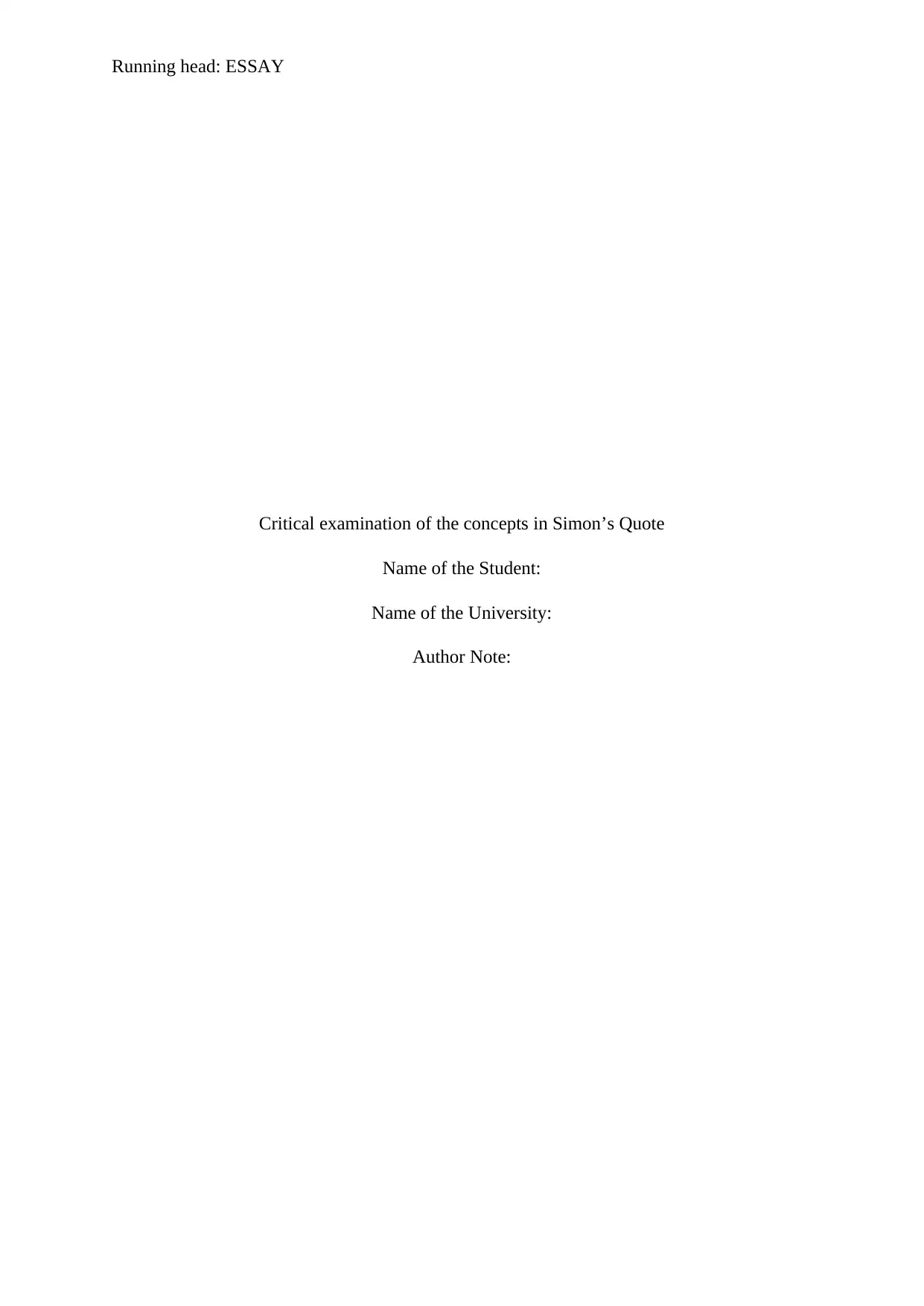
Running head: ESSAY
Critical examination of the concepts in Simon’s Quote
Name of the Student:
Name of the University:
Author Note:
Critical examination of the concepts in Simon’s Quote
Name of the Student:
Name of the University:
Author Note:
Paraphrase This Document
Need a fresh take? Get an instant paraphrase of this document with our AI Paraphraser
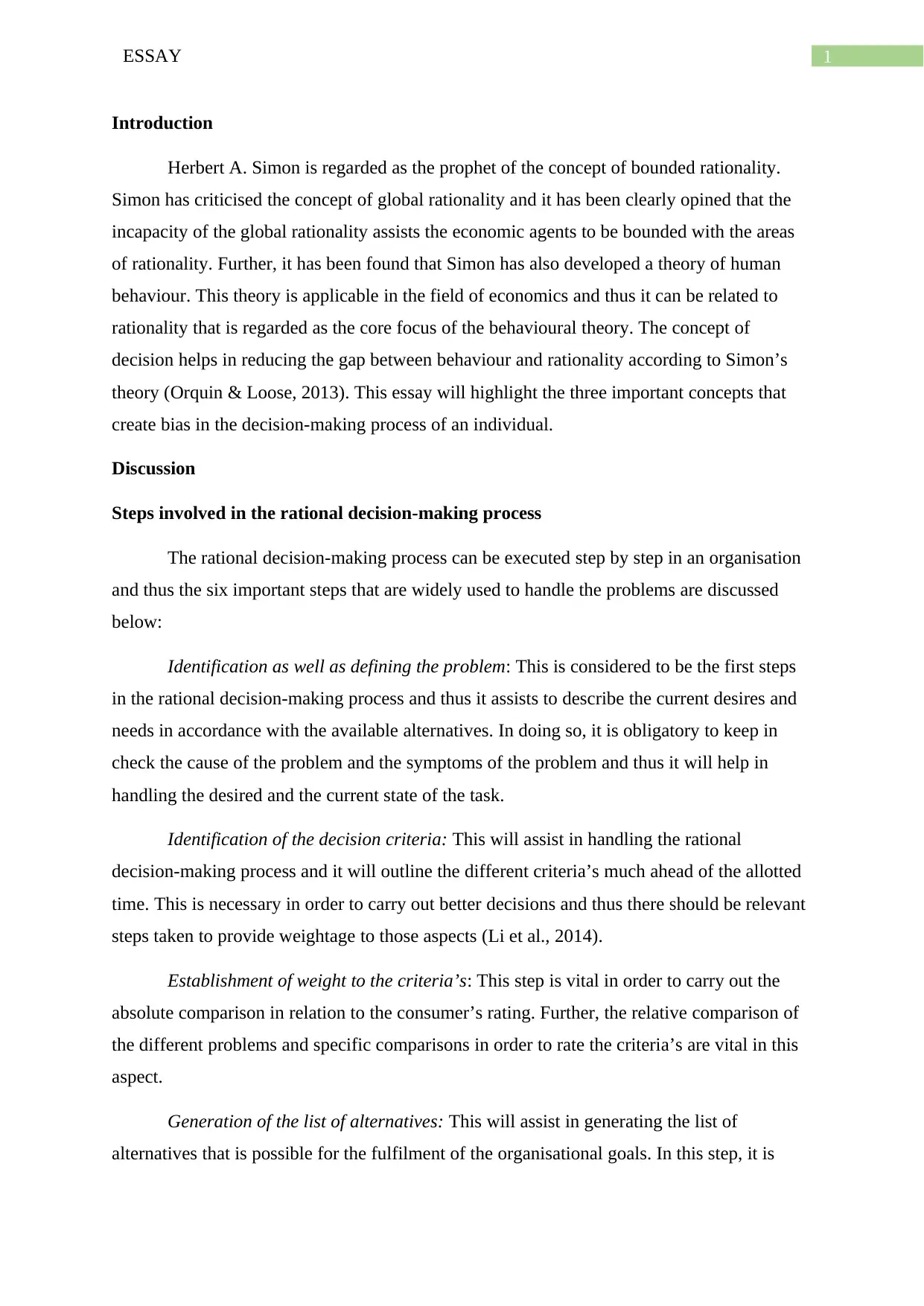
1ESSAY
Introduction
Herbert A. Simon is regarded as the prophet of the concept of bounded rationality.
Simon has criticised the concept of global rationality and it has been clearly opined that the
incapacity of the global rationality assists the economic agents to be bounded with the areas
of rationality. Further, it has been found that Simon has also developed a theory of human
behaviour. This theory is applicable in the field of economics and thus it can be related to
rationality that is regarded as the core focus of the behavioural theory. The concept of
decision helps in reducing the gap between behaviour and rationality according to Simon’s
theory (Orquin & Loose, 2013). This essay will highlight the three important concepts that
create bias in the decision-making process of an individual.
Discussion
Steps involved in the rational decision-making process
The rational decision-making process can be executed step by step in an organisation
and thus the six important steps that are widely used to handle the problems are discussed
below:
Identification as well as defining the problem: This is considered to be the first steps
in the rational decision-making process and thus it assists to describe the current desires and
needs in accordance with the available alternatives. In doing so, it is obligatory to keep in
check the cause of the problem and the symptoms of the problem and thus it will help in
handling the desired and the current state of the task.
Identification of the decision criteria: This will assist in handling the rational
decision-making process and it will outline the different criteria’s much ahead of the allotted
time. This is necessary in order to carry out better decisions and thus there should be relevant
steps taken to provide weightage to those aspects (Li et al., 2014).
Establishment of weight to the criteria’s: This step is vital in order to carry out the
absolute comparison in relation to the consumer’s rating. Further, the relative comparison of
the different problems and specific comparisons in order to rate the criteria’s are vital in this
aspect.
Generation of the list of alternatives: This will assist in generating the list of
alternatives that is possible for the fulfilment of the organisational goals. In this step, it is
Introduction
Herbert A. Simon is regarded as the prophet of the concept of bounded rationality.
Simon has criticised the concept of global rationality and it has been clearly opined that the
incapacity of the global rationality assists the economic agents to be bounded with the areas
of rationality. Further, it has been found that Simon has also developed a theory of human
behaviour. This theory is applicable in the field of economics and thus it can be related to
rationality that is regarded as the core focus of the behavioural theory. The concept of
decision helps in reducing the gap between behaviour and rationality according to Simon’s
theory (Orquin & Loose, 2013). This essay will highlight the three important concepts that
create bias in the decision-making process of an individual.
Discussion
Steps involved in the rational decision-making process
The rational decision-making process can be executed step by step in an organisation
and thus the six important steps that are widely used to handle the problems are discussed
below:
Identification as well as defining the problem: This is considered to be the first steps
in the rational decision-making process and thus it assists to describe the current desires and
needs in accordance with the available alternatives. In doing so, it is obligatory to keep in
check the cause of the problem and the symptoms of the problem and thus it will help in
handling the desired and the current state of the task.
Identification of the decision criteria: This will assist in handling the rational
decision-making process and it will outline the different criteria’s much ahead of the allotted
time. This is necessary in order to carry out better decisions and thus there should be relevant
steps taken to provide weightage to those aspects (Li et al., 2014).
Establishment of weight to the criteria’s: This step is vital in order to carry out the
absolute comparison in relation to the consumer’s rating. Further, the relative comparison of
the different problems and specific comparisons in order to rate the criteria’s are vital in this
aspect.
Generation of the list of alternatives: This will assist in generating the list of
alternatives that is possible for the fulfilment of the organisational goals. In this step, it is
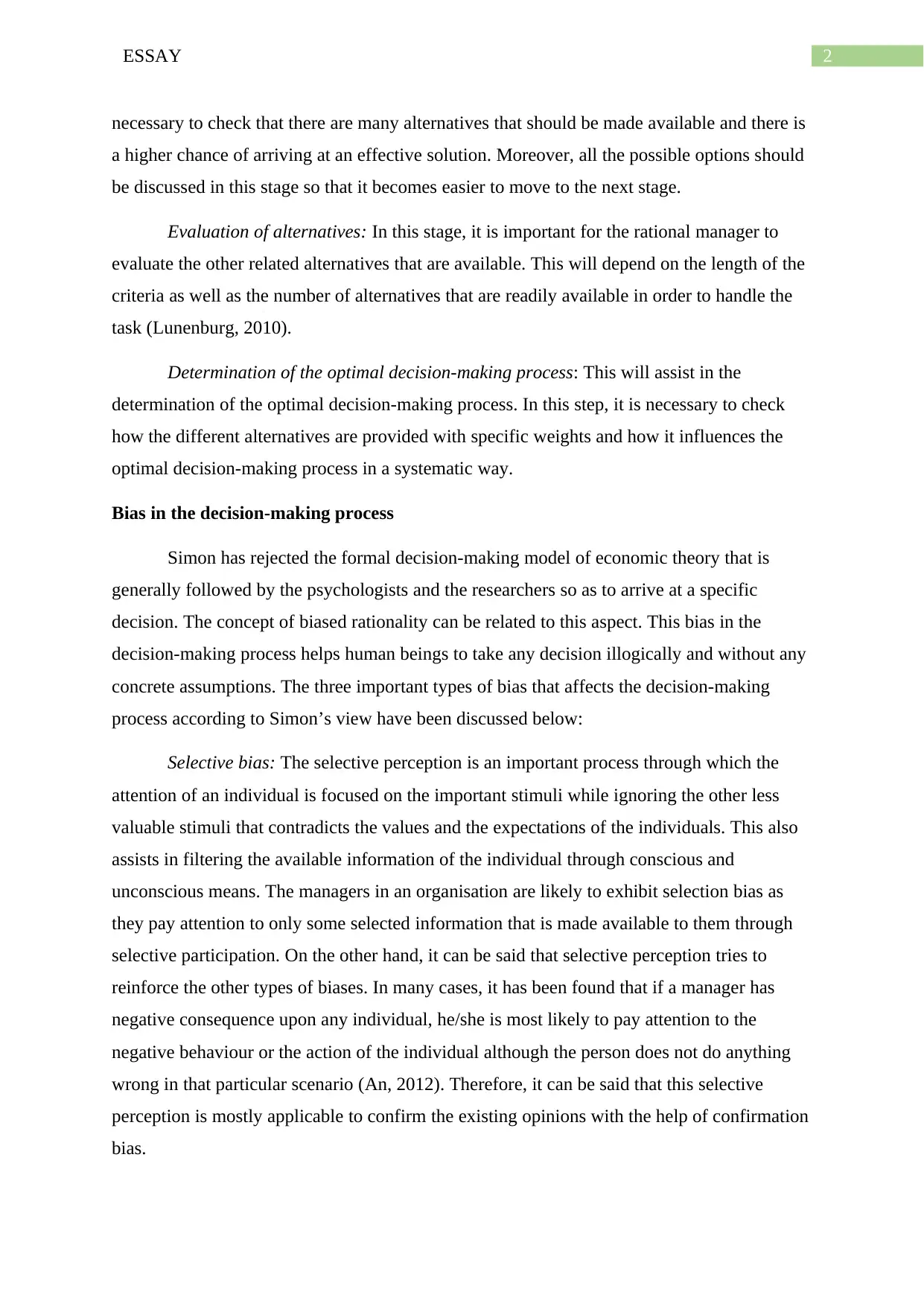
2ESSAY
necessary to check that there are many alternatives that should be made available and there is
a higher chance of arriving at an effective solution. Moreover, all the possible options should
be discussed in this stage so that it becomes easier to move to the next stage.
Evaluation of alternatives: In this stage, it is important for the rational manager to
evaluate the other related alternatives that are available. This will depend on the length of the
criteria as well as the number of alternatives that are readily available in order to handle the
task (Lunenburg, 2010).
Determination of the optimal decision-making process: This will assist in the
determination of the optimal decision-making process. In this step, it is necessary to check
how the different alternatives are provided with specific weights and how it influences the
optimal decision-making process in a systematic way.
Bias in the decision-making process
Simon has rejected the formal decision-making model of economic theory that is
generally followed by the psychologists and the researchers so as to arrive at a specific
decision. The concept of biased rationality can be related to this aspect. This bias in the
decision-making process helps human beings to take any decision illogically and without any
concrete assumptions. The three important types of bias that affects the decision-making
process according to Simon’s view have been discussed below:
Selective bias: The selective perception is an important process through which the
attention of an individual is focused on the important stimuli while ignoring the other less
valuable stimuli that contradicts the values and the expectations of the individuals. This also
assists in filtering the available information of the individual through conscious and
unconscious means. The managers in an organisation are likely to exhibit selection bias as
they pay attention to only some selected information that is made available to them through
selective participation. On the other hand, it can be said that selective perception tries to
reinforce the other types of biases. In many cases, it has been found that if a manager has
negative consequence upon any individual, he/she is most likely to pay attention to the
negative behaviour or the action of the individual although the person does not do anything
wrong in that particular scenario (An, 2012). Therefore, it can be said that this selective
perception is mostly applicable to confirm the existing opinions with the help of confirmation
bias.
necessary to check that there are many alternatives that should be made available and there is
a higher chance of arriving at an effective solution. Moreover, all the possible options should
be discussed in this stage so that it becomes easier to move to the next stage.
Evaluation of alternatives: In this stage, it is important for the rational manager to
evaluate the other related alternatives that are available. This will depend on the length of the
criteria as well as the number of alternatives that are readily available in order to handle the
task (Lunenburg, 2010).
Determination of the optimal decision-making process: This will assist in the
determination of the optimal decision-making process. In this step, it is necessary to check
how the different alternatives are provided with specific weights and how it influences the
optimal decision-making process in a systematic way.
Bias in the decision-making process
Simon has rejected the formal decision-making model of economic theory that is
generally followed by the psychologists and the researchers so as to arrive at a specific
decision. The concept of biased rationality can be related to this aspect. This bias in the
decision-making process helps human beings to take any decision illogically and without any
concrete assumptions. The three important types of bias that affects the decision-making
process according to Simon’s view have been discussed below:
Selective bias: The selective perception is an important process through which the
attention of an individual is focused on the important stimuli while ignoring the other less
valuable stimuli that contradicts the values and the expectations of the individuals. This also
assists in filtering the available information of the individual through conscious and
unconscious means. The managers in an organisation are likely to exhibit selection bias as
they pay attention to only some selected information that is made available to them through
selective participation. On the other hand, it can be said that selective perception tries to
reinforce the other types of biases. In many cases, it has been found that if a manager has
negative consequence upon any individual, he/she is most likely to pay attention to the
negative behaviour or the action of the individual although the person does not do anything
wrong in that particular scenario (An, 2012). Therefore, it can be said that this selective
perception is mostly applicable to confirm the existing opinions with the help of confirmation
bias.
⊘ This is a preview!⊘
Do you want full access?
Subscribe today to unlock all pages.

Trusted by 1+ million students worldwide
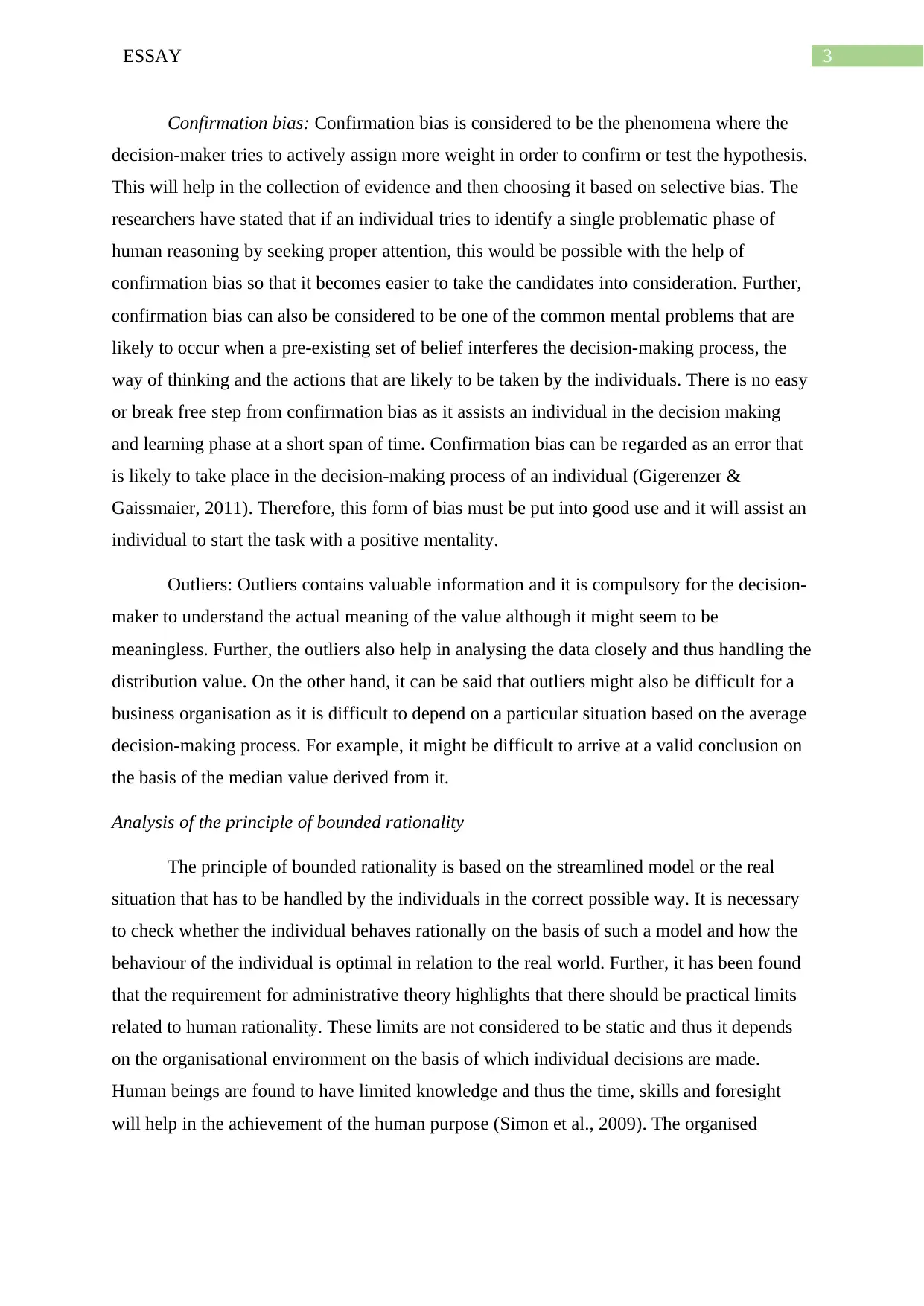
3ESSAY
Confirmation bias: Confirmation bias is considered to be the phenomena where the
decision-maker tries to actively assign more weight in order to confirm or test the hypothesis.
This will help in the collection of evidence and then choosing it based on selective bias. The
researchers have stated that if an individual tries to identify a single problematic phase of
human reasoning by seeking proper attention, this would be possible with the help of
confirmation bias so that it becomes easier to take the candidates into consideration. Further,
confirmation bias can also be considered to be one of the common mental problems that are
likely to occur when a pre-existing set of belief interferes the decision-making process, the
way of thinking and the actions that are likely to be taken by the individuals. There is no easy
or break free step from confirmation bias as it assists an individual in the decision making
and learning phase at a short span of time. Confirmation bias can be regarded as an error that
is likely to take place in the decision-making process of an individual (Gigerenzer &
Gaissmaier, 2011). Therefore, this form of bias must be put into good use and it will assist an
individual to start the task with a positive mentality.
Outliers: Outliers contains valuable information and it is compulsory for the decision-
maker to understand the actual meaning of the value although it might seem to be
meaningless. Further, the outliers also help in analysing the data closely and thus handling the
distribution value. On the other hand, it can be said that outliers might also be difficult for a
business organisation as it is difficult to depend on a particular situation based on the average
decision-making process. For example, it might be difficult to arrive at a valid conclusion on
the basis of the median value derived from it.
Analysis of the principle of bounded rationality
The principle of bounded rationality is based on the streamlined model or the real
situation that has to be handled by the individuals in the correct possible way. It is necessary
to check whether the individual behaves rationally on the basis of such a model and how the
behaviour of the individual is optimal in relation to the real world. Further, it has been found
that the requirement for administrative theory highlights that there should be practical limits
related to human rationality. These limits are not considered to be static and thus it depends
on the organisational environment on the basis of which individual decisions are made.
Human beings are found to have limited knowledge and thus the time, skills and foresight
will help in the achievement of the human purpose (Simon et al., 2009). The organised
Confirmation bias: Confirmation bias is considered to be the phenomena where the
decision-maker tries to actively assign more weight in order to confirm or test the hypothesis.
This will help in the collection of evidence and then choosing it based on selective bias. The
researchers have stated that if an individual tries to identify a single problematic phase of
human reasoning by seeking proper attention, this would be possible with the help of
confirmation bias so that it becomes easier to take the candidates into consideration. Further,
confirmation bias can also be considered to be one of the common mental problems that are
likely to occur when a pre-existing set of belief interferes the decision-making process, the
way of thinking and the actions that are likely to be taken by the individuals. There is no easy
or break free step from confirmation bias as it assists an individual in the decision making
and learning phase at a short span of time. Confirmation bias can be regarded as an error that
is likely to take place in the decision-making process of an individual (Gigerenzer &
Gaissmaier, 2011). Therefore, this form of bias must be put into good use and it will assist an
individual to start the task with a positive mentality.
Outliers: Outliers contains valuable information and it is compulsory for the decision-
maker to understand the actual meaning of the value although it might seem to be
meaningless. Further, the outliers also help in analysing the data closely and thus handling the
distribution value. On the other hand, it can be said that outliers might also be difficult for a
business organisation as it is difficult to depend on a particular situation based on the average
decision-making process. For example, it might be difficult to arrive at a valid conclusion on
the basis of the median value derived from it.
Analysis of the principle of bounded rationality
The principle of bounded rationality is based on the streamlined model or the real
situation that has to be handled by the individuals in the correct possible way. It is necessary
to check whether the individual behaves rationally on the basis of such a model and how the
behaviour of the individual is optimal in relation to the real world. Further, it has been found
that the requirement for administrative theory highlights that there should be practical limits
related to human rationality. These limits are not considered to be static and thus it depends
on the organisational environment on the basis of which individual decisions are made.
Human beings are found to have limited knowledge and thus the time, skills and foresight
will help in the achievement of the human purpose (Simon et al., 2009). The organised
Paraphrase This Document
Need a fresh take? Get an instant paraphrase of this document with our AI Paraphraser
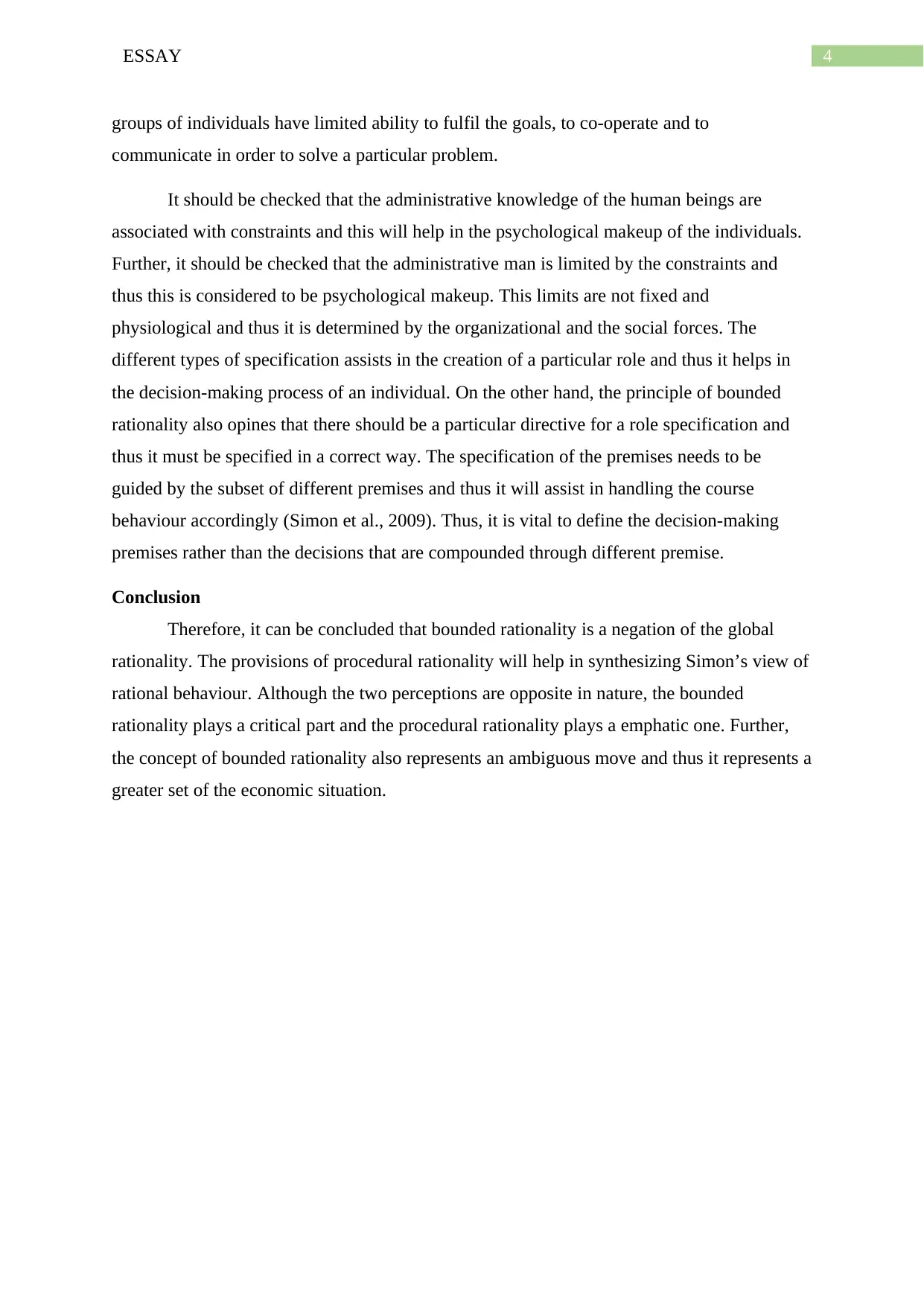
4ESSAY
groups of individuals have limited ability to fulfil the goals, to co-operate and to
communicate in order to solve a particular problem.
It should be checked that the administrative knowledge of the human beings are
associated with constraints and this will help in the psychological makeup of the individuals.
Further, it should be checked that the administrative man is limited by the constraints and
thus this is considered to be psychological makeup. This limits are not fixed and
physiological and thus it is determined by the organizational and the social forces. The
different types of specification assists in the creation of a particular role and thus it helps in
the decision-making process of an individual. On the other hand, the principle of bounded
rationality also opines that there should be a particular directive for a role specification and
thus it must be specified in a correct way. The specification of the premises needs to be
guided by the subset of different premises and thus it will assist in handling the course
behaviour accordingly (Simon et al., 2009). Thus, it is vital to define the decision-making
premises rather than the decisions that are compounded through different premise.
Conclusion
Therefore, it can be concluded that bounded rationality is a negation of the global
rationality. The provisions of procedural rationality will help in synthesizing Simon’s view of
rational behaviour. Although the two perceptions are opposite in nature, the bounded
rationality plays a critical part and the procedural rationality plays a emphatic one. Further,
the concept of bounded rationality also represents an ambiguous move and thus it represents a
greater set of the economic situation.
groups of individuals have limited ability to fulfil the goals, to co-operate and to
communicate in order to solve a particular problem.
It should be checked that the administrative knowledge of the human beings are
associated with constraints and this will help in the psychological makeup of the individuals.
Further, it should be checked that the administrative man is limited by the constraints and
thus this is considered to be psychological makeup. This limits are not fixed and
physiological and thus it is determined by the organizational and the social forces. The
different types of specification assists in the creation of a particular role and thus it helps in
the decision-making process of an individual. On the other hand, the principle of bounded
rationality also opines that there should be a particular directive for a role specification and
thus it must be specified in a correct way. The specification of the premises needs to be
guided by the subset of different premises and thus it will assist in handling the course
behaviour accordingly (Simon et al., 2009). Thus, it is vital to define the decision-making
premises rather than the decisions that are compounded through different premise.
Conclusion
Therefore, it can be concluded that bounded rationality is a negation of the global
rationality. The provisions of procedural rationality will help in synthesizing Simon’s view of
rational behaviour. Although the two perceptions are opposite in nature, the bounded
rationality plays a critical part and the procedural rationality plays a emphatic one. Further,
the concept of bounded rationality also represents an ambiguous move and thus it represents a
greater set of the economic situation.
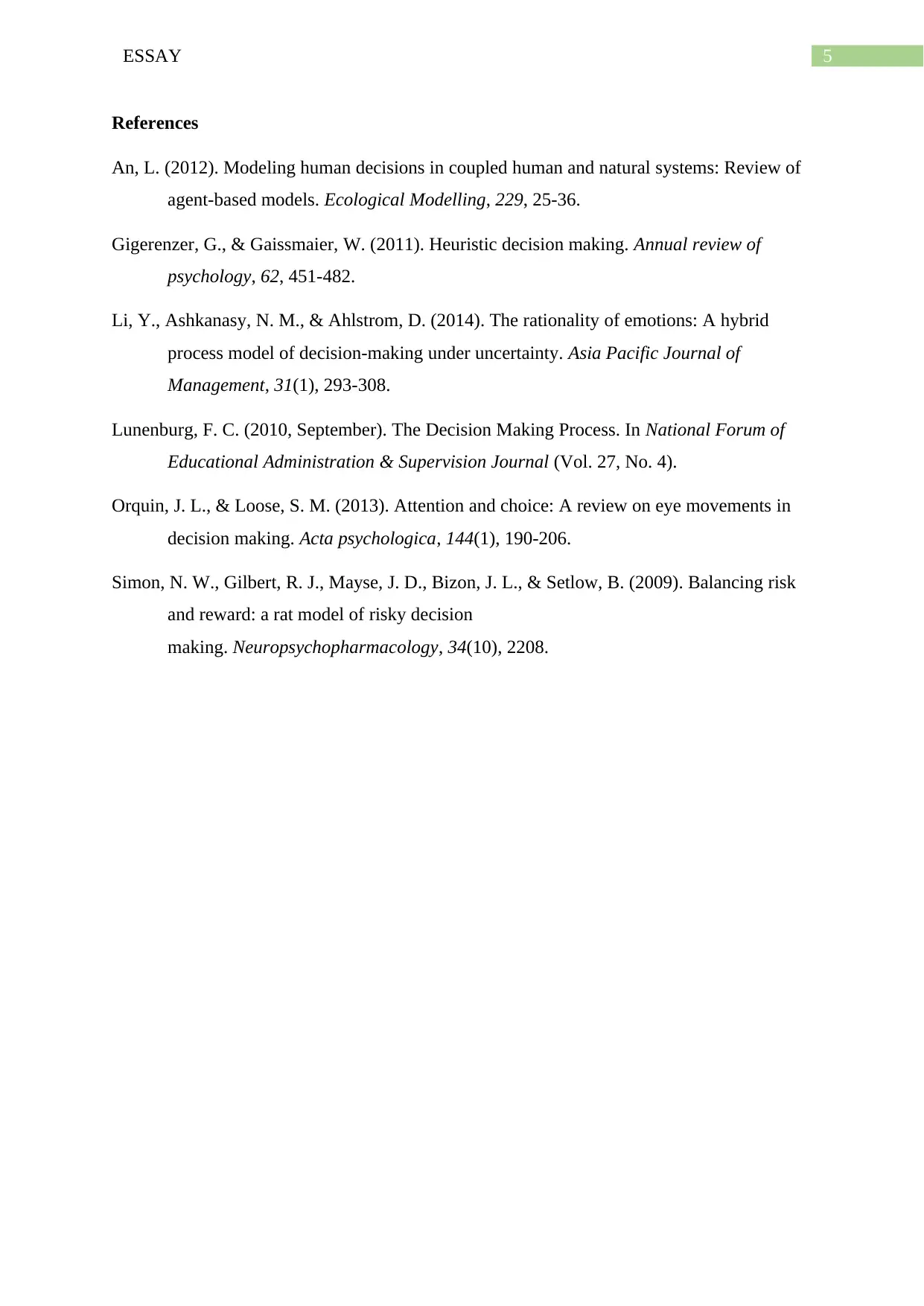
5ESSAY
References
An, L. (2012). Modeling human decisions in coupled human and natural systems: Review of
agent-based models. Ecological Modelling, 229, 25-36.
Gigerenzer, G., & Gaissmaier, W. (2011). Heuristic decision making. Annual review of
psychology, 62, 451-482.
Li, Y., Ashkanasy, N. M., & Ahlstrom, D. (2014). The rationality of emotions: A hybrid
process model of decision-making under uncertainty. Asia Pacific Journal of
Management, 31(1), 293-308.
Lunenburg, F. C. (2010, September). The Decision Making Process. In National Forum of
Educational Administration & Supervision Journal (Vol. 27, No. 4).
Orquin, J. L., & Loose, S. M. (2013). Attention and choice: A review on eye movements in
decision making. Acta psychologica, 144(1), 190-206.
Simon, N. W., Gilbert, R. J., Mayse, J. D., Bizon, J. L., & Setlow, B. (2009). Balancing risk
and reward: a rat model of risky decision
making. Neuropsychopharmacology, 34(10), 2208.
References
An, L. (2012). Modeling human decisions in coupled human and natural systems: Review of
agent-based models. Ecological Modelling, 229, 25-36.
Gigerenzer, G., & Gaissmaier, W. (2011). Heuristic decision making. Annual review of
psychology, 62, 451-482.
Li, Y., Ashkanasy, N. M., & Ahlstrom, D. (2014). The rationality of emotions: A hybrid
process model of decision-making under uncertainty. Asia Pacific Journal of
Management, 31(1), 293-308.
Lunenburg, F. C. (2010, September). The Decision Making Process. In National Forum of
Educational Administration & Supervision Journal (Vol. 27, No. 4).
Orquin, J. L., & Loose, S. M. (2013). Attention and choice: A review on eye movements in
decision making. Acta psychologica, 144(1), 190-206.
Simon, N. W., Gilbert, R. J., Mayse, J. D., Bizon, J. L., & Setlow, B. (2009). Balancing risk
and reward: a rat model of risky decision
making. Neuropsychopharmacology, 34(10), 2208.
⊘ This is a preview!⊘
Do you want full access?
Subscribe today to unlock all pages.

Trusted by 1+ million students worldwide
1 out of 6
Related Documents
Your All-in-One AI-Powered Toolkit for Academic Success.
+13062052269
info@desklib.com
Available 24*7 on WhatsApp / Email
![[object Object]](/_next/static/media/star-bottom.7253800d.svg)
Unlock your academic potential
Copyright © 2020–2025 A2Z Services. All Rights Reserved. Developed and managed by ZUCOL.





